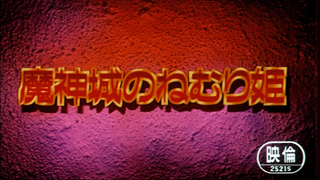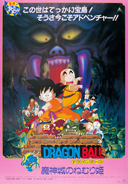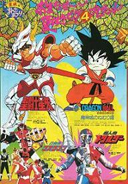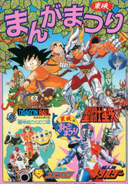
魔神城のねむり姫
Majin Jō no Nemuri Hime
The Sleeping Princess in Devil’s Castle
General Information
| Premiered: | 18 July 1987 (“Toei Cartoon Festival”) |
| EIRIN Code: | 25215 |
| Running Time: | Approx. 46 minutes |
| Box Office: | Total Gross: Unknown Net Earnings: ¥850 million (approx. US $5.67 million ) Attendance: 2.6 million |
| Opening Animation: | “Mystical Adventure!” (Dragon Ball Movie 2 Animation) |
| Ending Animation: | “I’ll Give You Romance” (Dragon Ball Movie 2 Animation) |
|
|
|
| Availability: |
VHS (11 December 1987 – Original Print / 21 July 1996 – Re-issue) Betamax and 8mm Film (11 December 1987) Dragon Box The Movies; Disc #02 (14 April 2006) Dragon Ball The Movies Individual DVD Volume #16 (13 March 2009) Dragon Ball The Movies Blu-ray Volume #08 (09 January 2019) |
Movie Premiere & Promotion
The movie premiered as part of the Summer 1987 “Toei Cartoon Festival” (東映まんがまつり; Tōei Manga Matsuri) on 18 July 1987, along with three other movies from the Saint Seiya, Hikari Sentai Maskman, and Chōjinki Metalder series. The “Toei Cartoon Festival” was established by Toei in 1969 as a way to showcase their popular children’s series as theatrical films during seasonal breaks in the school year: spring vacation, summer vacation, and winter vacation. In Japan, almost all schools below the university level run a three-term school year (trimester system) with a vacation period of several weeks to a month at the end of each trimester. The movies were screened together back-to-back in various cities across Japan, with a typical total running time of roughly three hours. Most festivals would last roughly one month, or as long as the seasonal vacation allowed. Tickets could be purchased at the theater, or discount tickets could be purchased in advance which covered the cost of admission, as well as a bonus item such as a promotional pamphlet describing the featured movies, and various other special presents, such as posters, paper hats, cards, and toys. Additional items, including the official theatrical pamphlet and a variety of other commemorative goods, were available for purchase at cinemas or by mail during this period.
Home Video Release
Up until the Dragon Box DVD sets began being released in the early 2000s, the only Dragon Ball properties released to home video in Japan were the original seventeen theatrical films, most of which were available on VHS, LaserDisc, and 8mm film reels. These home video releases were a luxury for most fans, as they came at a rather high price point for the time. They were later re-released in 1996 to replace the then out-of-print VHS tapes with a lower price point and slightly different covers.
After releasing the entirety of the three Dragon Ball TV series, Toei released their fifth and final “Dragon Box”, which was entitled “Dragon Box The Movies”. The Dragon Box contained all seventeen original Dragon Ball movies presented in their theatrical 16:9 widescreen aspect ratio. As a special bonus for the movie’s first DVD release, Toei dug through their vaults and included some of the movie’s original promotional material.
| Theatrical Preview (劇場予告) Running Time: 25 seconds |
 |
| Digest (ダイジェスト) Running Time: 1 minute, 10 seconds |
|
Following the “Dragon Box”, Toei began releasing each movie individually on DVD. To help promote the sale of movie individual discs, Shueisha handed out a free promotional DVD highlighting the releases at Jump Festa 2009. The DVD contained promotional trailers for each movie which were narrated by veteran Dragon Ball cast member Shigeru Chiba, the voice of such notable characters as Pilaf, Garlic Jr. (TV series), and Raditz. More information about the promotional DVD is available in our “Home Video Guide”.
In July 2018, the original seventeen theatrical films were released on Japanese Netflix and Amazon Prime streaming services. The addition of the movies themselves was heavily promoted throughout social media, however it was not announced or promoted at the time that they were actually new, high-definition remasters of the films scanned, and subsequently remastered, from the original film negatives. Shortly thereafter on 09 August 2018, Toei Animation formally announced the release of these newly-remastered versions of the movies across eight Blu-ray volumes. All non-credit versions of the opening and endings included with the release are up-converts of those originally included on the original LaserDisc releases and all bonus promotional materials (trailers, digests, etc.) are presented in their original standard definition format as included in the Dragon Box release.
Movie Synopsis
Goku heads to Kame House to train with Kame-Sen’nin, but when he arrives, Kame-Sen’nin is “busy”. Goku shouts in his ear, and finally gets his attention. Shortly after, Kuririn arrives on the island and requests that Kame-Sen’nin take him on as a student, as well. After some bribing, Kame-Sen’nin says he will accept one of them as a student, but only whichever one returns with the “Sleeping Princess”.
The boys set off toward Devil Castle, where the “Sleeping Princess” is said to be. Meanwhile, Bulma and the others tail Goku, but as they approach Devil Castle, they are attacked, and Bulma is kidnapped. After losing consciousness, Bulma wakes up in a lavish room. The owner of the castle, Lucifer, introduces himself and treats Bulma as an honored guest.
Goku and Kuririn sneak into the castle, but are soon swarmed by demons that have learned of their ambitions to take the “Sleeping Princess”. Lucifer escorts Bulma to a giant room, and informs Bulma that it is time to awaken the “Sleeping Princess”. As she is tied to a chair, Bulma realizes she is going to be used as a sacrifice. Suddenly, Goku’s and Kuririn’s battle with the demons crashes into the room. Goku ends up under an altar, where he finds the jewel known as the “Sleeping Princess”.
Lunch, a violent, blonde thief, rides into the room and quickly snatches the jewel from Goku. Goku gives chase, but after obtaining the jewel, he is forced to hand it over to Lucifer in exchange for Kuririn, who has been captured. Everyone is rounded up and encased in a wall of rock. Lucifer plans to use the jewel to power a beam cannon that he will use to destroy the sun. The “Sleeping Princess” is finally awakened with the light of the full moon, but this also triggers Goku’s transformation into a giant ape.
As Goku rampages through the castle, Pu’er eventually manages to cut off his tail, returning him to normal. Goku then takes on Lucifer and fires a Kamehameha at the beam cannon, destroying it. As it explodes, the out-of-control energy from the “Sleeping Princess” engulfs Lucifer, killing him. Everyone escapes, and the two boys return to Kame House with Lunch, who has transformed into a docile, dark-haired form. Kame-Sen’nin then accepts them both as his students. Kame-Sen’nin takes Lunch inside the house, but she suddenly sneezes and transforms back into her blonde form, riddling our heroes with bullets.
Movie Characters & Items
The following original character profiles were translated from Daizenshuu 6, with additional character design comments from the movie’s character designer, Minoru Maeda, as published in the “Design Lab” section of the “Dragon Box The Movies” Dragon Book.
-
Lucifer (ルシフェル; rushiferu)
The lord of Devil Castle. At first sight he has a gentlemanly air, but he has a terrifying true face. He seems to be proficient at hand-to-hand combat, and has skill on par with Goku.In terms of his image… I suppose it’s Sally [the Witch]’s father. (laughs) Like with the shape of his hair. I made him a handsome man due to the nature of the tale, but this type of villain may actually be pretty rare in Dragon Ball.
— Minoru Maeda -
Butler (執事; shitsuji)
The fiend who takes care of things around Lucifer. He enjoys extracting the blood of beautiful women with a gigantic needle.The truth is, I took a character who appeared in Dr. Slump — Arale-chan and used him as-is for this butler.
— Minoru Maeda -
Ghastel (ガステル; gasuteru)
The fiend assigned to the security of Devil Castle, who is accompanied by his underlings. He flies by generating things similar to Kinto-Un under his feet.For Ghastel’s clothes, I used the costume of ancient China as a reference. In contrast to Kinto-Un, he rides on balls of fire under his feet; this was the director’s idea.
— Minoru Maeda -
Demons (魔物たち; mamono-tachi)
The many demons that inhabit Devil Castle. It seems that there are those with two necks, those who use machine guns, and various other small monster types.I made them in the image of imps, or demons of hell, to resemble Ghastel. In order to have a flashy gunfight, I gave them machine guns in a deliberate [stylistic] mismatch.
— Minoru Maeda
Items
-
Sleeping Princess (ねむり姫; nemuri hime)
Long ago, there was a beautiful young girl who was kidnapped by devils and imprisoned in Devil Castle. It was said that from then on, she continued sleeping for thousands of years inside a dark room, but the eyes of whoever saw her would be paralyzed by her great beauty. However, the Sleeping Princess’s true identity turns out to be a gigantic jewel with formidable hidden power that is awakened by the light of the full moon. -
Beam Cannon (光線砲; kōsen-hō)
Developed by Lucifer and his underlings, it was designed to utilize the formidable power of the Sleeping Princess jewel to destroy the sun.
Movie Notes
- This movie is an alternative re-telling of the second Dragon Ball story arc, roughly covering chapters 024-031, or episodes 014-018 of the original Dragon Ball TV series. Daizenshuu 6 does not distinctly classify this movie as an event that takes place in an alternate world, but rather notes that it conflicts with the events of the original story:
Goku and Kuririn becoming pupils under Kame-Sen’nin and Yamcha’s objective of searching for the Dragon Balls are the same as the TV version. However, points such as seeking out the Sleeping Princess being a part of the training do not synch up with the timeline of the TV show.
— “Dragon Ball Daizenshuu 6: Movies & TV Specials” (p. 24) - Although this movie was presented in a 16:9 widescreen aspect ratio in theaters, it was actually animated in a 4:3 fullscreen format. In fact, when the movie was initially released in 1987 on VHS and Betamax, it was presented in this 4:3 fullscreen format. However, the “Dragon Box The Movies” release would later drop this format, instead presenting all of the movies in their original widescreen theatrical format. Overall, this movie has been released to the home market on VHS, Betamax, 8mm film reel, DVD, and Blu-ray.
- The movie was eventually adapted and released by Shueisha as a film animation comic in February 1995, and subsequently re-released under Shueisha’s “Jump Remix” line in July 2005.
Name Puns
- The first “Memorial” section in Daizenshuu 6 explains that Lucifer was “modeled after a demon from the Bible”. In fact, his name comes directly from Lucifer, the name many Christians treat as the Devil’s original angelic name. Although it was presumably not the staff’s intention, it is quite ironic that the word “Lucifer” means “Light Bringer” in Latin, whereas in the movie, the character attempts to destroy the sun.
- The Supplemental Daizenshuu states that Ghastel’s name is derived from the wasei-eigo term “gas table”, which refers to a kitchen appliance containing one or more gas burners, and possibly a broiler for cooking fish. “Gas tables” are used in older Japanese homes that do not have a “system kitchen”, where a cooking stove is instead built into the kitchen unit.
ガステーブル (ga·su·te·e·bu·ru) › ガステル (ga·su·te·ru)
Movie Credits
All credits listed below are as originally presented in the theatrical film. All original credit errors have been corrected to maintain accurate spellings throughout the site. For more information and a complete listing of the series staff, visit the Production Guide.
Cast Credits
The cast credits are listed in order of character importance within the series. For more detailed information about the series cast, visit the Cast Guide.
-
孫悟空
Son Goku
-
野沢雅子
Masako Nozawa
-
ヤムチャ
Yamcha
-
古谷 徹
Tōru Furuya
-
ランチ
Lunch
-
小山茉美
Mami Koyama
-
クリリン
Kuririn
-
田中真弓
Mayumi Tanaka
-
ブルマ
Bulma
-
鶴 ひろみ
Hiromi Tsuru
-
ウーロン
Oolong
-
龍田直樹
Naoki Tatsuta
-
プーアル
Pu’er
-
渡辺菜生子
Naoko Watanabe
-
亀仙人
Kame-Sen’nin
-
宮内幸平
Kōhei Miyauchi
-
執事
Butler
-
飯塚昭三
Shōzō Īzuka
-
ガステル
Ghastel
-
郷里大輔
Daisuke Gōri
-
インストラクター
Instructor
-
川浪葉子
Yōko Kawanami
-
魔人
Demon
-
田中亮一
Ryōichi Tanaka
沢木郁也
Ikuya Sawaki
田中和実
Kazumi Tanaka
岡 和男
Kazuo Oka
平野正人
Masato Hirano
-
ナレーター
Narrator
-
八奈見乗児
Jōji Yanami
-
ルシフェル
Lucifer
-
野沢那智
Nachi Nozawa
Opening Credits
-
製作総指揮
Executive Producer
-
今田智憲
Chiaki Imada
-
原作
Original Author
-
鳥山 明
Akira Toriyama
-
(週刊少年ジャンプ・連載)
(Weekly Shōnen Jump – Serialization)
-
企画
Planning
-
七條敬三
Keizō Shichijō
-
製作担当
Production Manager
-
岸本松司
Shōji Kishimoto
-
脚本構成
Scenario Composition
-
由木義文
Yoshifumi Yuki
-
脚本
Script
-
照井啓司
Keiji Terui
-
音楽
Music
-
菊池俊輔
Shunsuke Kikuchi
-
オープニング テーマ
Opening Theme
作詞
Lyrics
作曲
Composition
編曲
Arrangement
うた
Vocals
-
「魔訶不思議アドベンチャー!」
“Mystical Adventure!”
森 由里子
Yuriko Mori
いけたけし
Takeshi Ike
田中公平
Kōhei Tanaka
高橋洋樹
Hiroki Takahashi
-
(コロムビアレコード)
(Columbia Records)
-
エンディング テーマ
Ending Theme
作詞
Lyrics
作曲
Composition
編曲
Arrangement
うた
Vocals
-
「ロマンティックあげるよ」
“I’ll Give You Romance”
吉田健美
Takemi Yoshida
いけたけし
Takeshi Ike
田中公平
Kōhei Tanaka
橋本 潮
Ushio Hashimoto
-
(コロムビアレコード)
(Columbia Records)
-
撮影
Photography
-
池上元秋
Motoaki Ikegami
-
編集
Editing
-
福光伸一
Shin’ichi Fukumitsu
-
録音
Recording
-
二宮健治
Kenji Ninomiya
-
美術監督
Art Director
-
伊藤岩光
Iwamitsu Itō
-
補佐
Assistant
-
塩崎広光
Hiromitsu Shiozaki
-
作画監督
Animation Supervisor
-
前田 実
Minoru Maeda
-
監督
Director
-
西尾大介
Daisuke Nishio
Ending Credits
-
声の出演
Voice Performances
-
~~~~
[ Cast Credits ]
-
協力
In Cooperation With
-
青二プロ
Aoni Production
-
原画
Key Animation
-
青嶋克己
Katsumi Aoshima
竹内留吉
Tomekichi Takeuchi
荒牧園美
Sonomi Aramaki
中鶴勝祥
Katsuyoshi Nakatsuru
劉 輝久
Teruhisa Ryū
三角昌子
Masako Misumi
-
海老沢幸男
Yukio Ebisawa
小原太一郎
Tai’ichirō Ohara
井手武生
Takeo Ide
清水保行
Yasuyuki Shimizu
島貫正弘
Masahiro Shimanuki
内山正幸
Masayuki Uchiyama
-
動画
In-Between Animation
-
白須順子
Yoshiko Shirasu
鈴木初枝
Hatsue Suzuki
三柴直樹
Naoki Mishiba
中村まゆみ
Mayumi Nakamura
星野紀美子
Kimiko Hoshino
飯田倫也
Tomoya Iida
三浦辰夫
Tatsuo Miura
江原 仁
Hitoshi Ehara
増田清美
Kiyomi Masuda
呉 偉峯
Eramine Kure
-
水梨ひとみ
Hitomi Mizunashi
佐藤和香子
Wakako Satō
望月啓史
Hiroshi Mochizuki
松本明子
Akiko Matsumoto
西川秀明
Hideaki Nishikawa
工藤誉寿治
Yosuji Kudō
中村美雪
Miyuki Nakamura
棚橋香矛
Kahoko Tanahashi
久田和也
Kazuya Hisada
舘 直樹
Naoki Tate
-
動画チェッカー
In-Between Animation Checker
-
佐野哲郎
Tetsurō Sano
-
背景
Backgrounds
-
谷口淳一
Jun’ichi Taniguchi
行 信三
Shinzō Yuki
上田三輪子
Miwako Ueda
佐藤美幸
Miyuki Satō
澤井裕滋
Hiroshige Sawai
-
千田国広
Kunihiro Chida
吉池隆司
Ryūji Yoshiike
堀越幸江
Yukie Horikoshi
今野良子
Ryōko Imano
安西徹夫
Tetsuo Anzai
-
仕上
Finishing Touches
-
入江美帆子
Mihoko Irie
上村育代
Ikuyo Uemura
斉藤広美
Hiromi Saitō
増井美知子
Michiko Masui
-
大堀陽子
Yōko Ōbori
鈴木美佐子
Misae Suzuki
萩野 優
Yū Hagino
鈴木安子
Yasuko Suzuki
-
検査
Inspection
-
藤岡真子
Mako Fujioka
-
特殊効果
Special Effects
-
平尾千秋
Chiaki Hirao
-
撮影
Photography
-
前原勝則
Katsunori Maehara
大藤哲生
Tetsuo Ōfuji
黒田洋一
Yōichi Kuroda
野口博志
Hiroshi Noguchi
伊藤るり子
Ruriko Itō
杉山知子
Tomoko Sugiyama
-
鈴木典子
Noriko Suzuki
佐伯 清
Kiyoshi Saeki
池谷和美
Kazumi Iketani
伊藤 寛
Hiroshi Itō
難波充子
Michiko Nanba
-
オーディオディレクター
Audio Director
-
小松亘弘
Nobuhiro Komatsu
-
音響効果
Sound Effects
-
新井秀徳
Hidenori Arai
-
ネガ編集
Negative Editing
-
禾几直子
Naoko Kaki
-
録音助手
Recording Assistant
-
内田義夫
Yoshio Uchida
-
監督助手
Assistant Director
-
橋本光夫
Mitsuo Hashimoto
-
記録
Documentation
-
柴 八千穂
Yachiho Shiba
-
仕上進行
Finishing Manager
-
植木知子
Tomoko Ueki
-
美術進行
Art Manager
-
中村 実
Minoru Nakamura
-
製作進行
Assistant Production Manager
-
末永雄一
Yūichi Suenaga
-
録音スタジオ
Recording Studio
-
タバック
TAVAC
-
現像
Film Developing
-
東映化学
Toei Chemistry
















